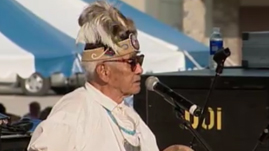Teachers' Domain - Digital Media for the Classroom and Professional Development
User: Preview



The Raven Rock Dancers perform the Beaver Dance, a social dance depicting the actions of a hunting party, at the 2006 Festival of Native Peoples. The Raven Rock Dancers is a family group founded by Walker Calhoun, a respected Cherokee elder.
This resource is part of the Native American Culture collection.
Find additional arts resources for your classroom at the KET Arts Toolkit website.
Not all Native American dances are ceremonial. Some are considered social. Although these social dances have meaning and often relate stories, they are not prayers like the ceremonial dances. Social dances are often connected to seasonal or life-cycle events and to the history and way of life of the tribes. So, like ceremonial dances, they are unique to specific tribes or regions.
The Cherokee Beaver Dance is a social dance that recreates the movement of hunting for beaver in an entertaining way. An animal skin meant to represent a beaver is pulled back and forth on a series of skins while dancers attempt to hit it. When they miss, it is considered amusing.
John Bullet Standingdeer, a member of the Warriors of AniKituhwa of Cherokee, N.C., has more than 40 years experience as a Native American dancer. According to Standingdeer, the Beaver Dance always features a man and woman showing their unity in preserving the life of the tribe. He says that Cherokee music developed from the practice of vocalized prayer and that the dance evolved according to the rhythms of the music. The rhythm of the drums becomes a guide for the dancers’ breathing patterns, movement, and footwork, unifying the dance in one common beat that represents the heartbeat of the dancers. As well as being a form of entertainment, the performance of this dance provides a connection to the ancestors and ancient spirits of the Cherokee.
It is a common misconception to think that Native Americans dressed in buckskin until recently. As soon as European trade goods were introduced, tribes developed their own distinctive clothing styles using newly introduced materials. These clothing styles are often part of the regalia of native dancers, such as that worn by the Raven Rock Dancers.
 Loading Standards
Loading Standards